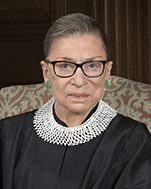On Friday, September 18th, 2020, the United States Supreme Court announced the death of Associate Justice Ruth Bader Ginsburg at the age of 87.

According to the court, Justice Ginsburg, who was appointed by President Bill Clinton and sworn in in 1993, died from complications from pancreatic cancer.
According to news reports, Ginsburg has a long resume of accomplishments, serving as the second woman and first jewish woman at the supreme court. From all indications, Justice Ginsburg was indeed a very impactful justice and major player in the women’s suffrage movement.
Why are we reporting on this?
Ginsburg’s death is obviously a major blow for her family. We will all die someday, but it is never easy to lose a mother, regardless of how old or accomplished they were. In addition to this, the timing of her death came at the worst time for the nation that is already sharply divided in a Presidential election year.
Justice Ginsberg was a controversial justice.
She was explained in a 1990 New York Times magazine interview that she thought the intention of Roe v. Wade was to allow for a vehicle for setting up Medicaid to fund abortions.
the ruling [Harris vs. McRae] about that surprised me. Frankly I had thought that at the time Roe was decided, there was concern about population growth and particularly growth in populations that we don’t want to have too many of. So that Roe was going to be then set up for Medicaid funding for abortion…
In discussing the Harris v. McRae case, Justice Ginsburg said she was surprised by the outcome. Her surprise was for the following really dangerous reasons: she thought Roe was decided at a time where there was concerns over population growth and there are some populations that were not wanted. This interview showed a rare window into her mind. Support of abortion was centered around population control and she things federal funding of abortions would have achieved that goal.
Some say here quote was taken out of context and the magazine should have followed up to force her to clarify. However, for those in poor communities littered with abortion clinics, it gets them to begin to wonder why abortion proponents push so hard to have such clinics mostly in poor communities. Justice Ginsburg’s take on Roe, (as reported on the NYT magazine interview by Emily Bazelon), were so controversial that three years later in 2012, the reporter tried to clear air and water down the controversy. More of this clarifying report can be found here: https://slate.com/news-and-politics/2012/10/ruth-bader-ginsburg-clears-up-her-views-on-abortion-population-control-and-roe-v-wade.html and https://www.snopes.com/fact-check/ruth-bader-ginsburg-and-roe-v-wade/
Regardless of our take, it is obvious that the Justice’s other works on women rights gained her a lot of respect.
Why does this example of her past matter?
Her death will set up an unprecedented fight to fill her seat. Christian evangelicals will fight to influence the nomination of someone that does not support abortion as a population control mechanism in poor communities. Abortion (pro-choice) supporters would fight to have someone nominated that would continue the legacy of associate justice Ruth Bader Ginsburg.
She was an example of America at its best.
In spite of her extreme views on abortion relative to population control, she turns out to be able to set all that aside and make friends with people with different believes. An example is her relationship with late justice Scalia.
May her family be comforted as they mourn their mother and sister.

